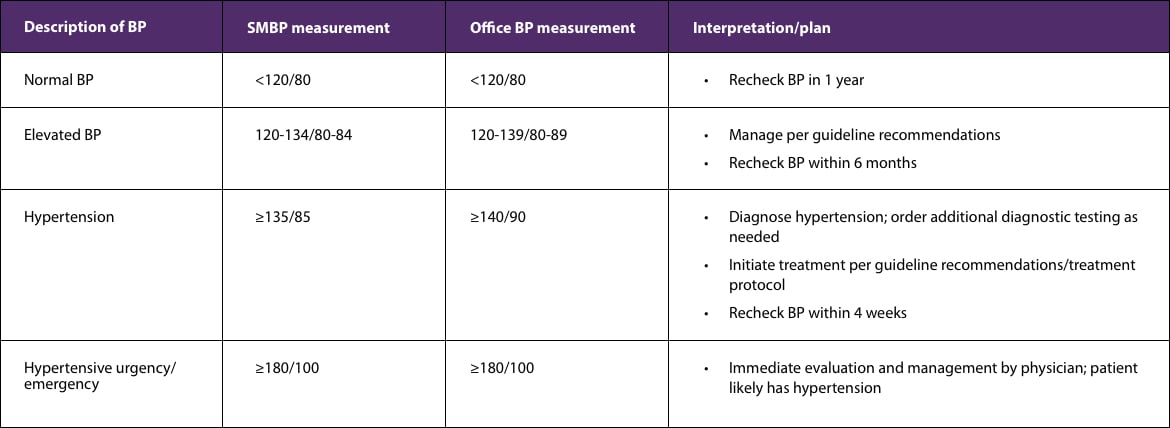Interpreting SMBP measurements
For SMBP measurement interpretation, an average systolic BP and average diastolic BP of 135/85 mm Hg is considered equivalent to 140/90 mm Hg in the clinical setting. If the BP used to diagnose hypertension and as a treatment target in the clinical setting is 140/90 mm Hg, the corresponding SMBP diagnostic threshold and treatment target is 135/85 mm Hg.
In the 2017 American College of Cardiology/American Heart Association "Guideline for the Prevention, Detection, Evaluation, and Management of High Blood Pressure in Adults," 130/80 mm Hg is used as the diagnostic threshold for hypertension.1 When following the recommendations in this guideline, 130/80 mm Hg can be used for most patients as the treatment target for hypertension in clinical settings and for SMBP. The ultimate judgment regarding treatment targets and management plans must be made by physicians and patients based on individual patient factors.
The measurement ranges and interpretations presented in the tables are based on the 2003 "Seventh report of the joint national committee on prevention, detection, evaluation, and treatment of high blood pressure" (JNC-7) diagnostic and treatment target thresholds.2 If the 2017 ACC/AHA Hypertension Clinical Practice Guideline is used, hypertension is defined as BP > 130/80 mm Hg for both office-based measurements and SMBP, and controlled BP for most adults is defined as < 130/80 mm Hg.
SMBP classifications
Patients without a diagnosis of hypertension
Patients with an existing diagnosis of hypertension
For both tables, if systolic and diastolic BPs are in different categories, defer to the higher category of BP.
Access the 7-step SMBP quick guide
The guide highlights seven key steps physicians and care teams can take to use SMBP with patients 18 years and older with high blood pressure, and includes links to useful supporting resources.
Essential AMA resources
- SMBP training video
- SMBP training video (Spanish)
- SMBP infographic (available in 18 languages)
- SMBP recording log
- SMBP CPT® coding
- SMBP Coverage Insights: Medicaid
- SMBP Policy Brief: Medicaid (PDF)
- SMBP benefits for patients with Medicaid
References
1 Whelton PK, Carey RM, Aronow WS, Casey DE Jr, Collins KJ, Dennison Himmelfarb C, et al. 2017 ACC/AHA/AAPA/ABC/ACPM/AGS/APhA/ASH/ ASPC/NMA/PCNA guideline for the prevention, detection, evaluation and management of high blood pressure in adults: A report of the American College of Cardiology/American Heart Association Task Force on Clinical Practice Guidelines. J Am Coll Cardiol. 2018;71(19).
2 Chobanian AV, Bakris GL, Black HR, et al; the National High Blood Pressure Education Program Coordinating Committee. Seventh report of the joint national committee on prevention, detection, evaluation, and treatment of high blood pressure. Hypertension. 2003;42:1206–52.
Disclaimer: These steps are for informational purposes only. These steps are not intended as a substitute for the medical advice of a physician; they offer no diagnoses or prescription. Furthermore, this information should not be interpreted as setting a standard of care or be deemed inclusive of all proper methods of care, nor exclusive of other methods of care reasonably directed to obtaining the same results. This protocol reflects the best available evidence at the time that it was prepared. The results of future studies may require revisions to the recommendations in this protocol to reflect new evidence, and it is the clinician's responsibility to be aware of such changes.





